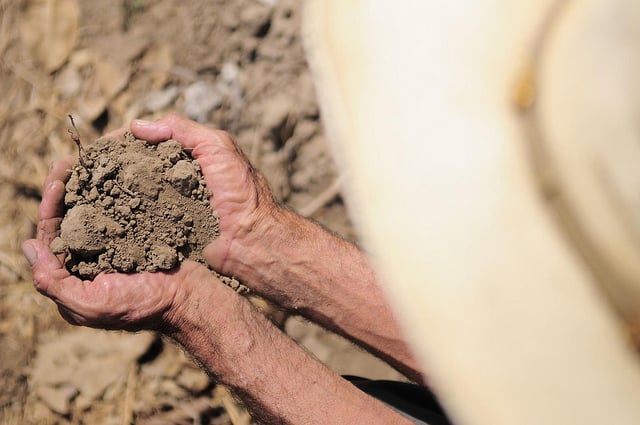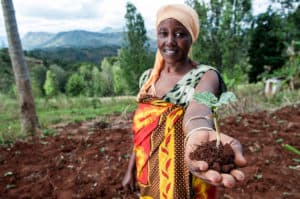Grow more food and mitigate climate change? Agricultural soil data could help
A more comprehensive understanding of agricultural soils is needed to support sustainable development decision making – but collecting the necessary data is challenging.

Photo by Neil Palmer
A Photoacoustic Gas Monitor sits in a plastic children’s sled in the middle of a churned up mix of soil and manure.
After securely attaching a cap over a plastic PVC ring buried 6 inches in the ground, I start the machine and watch as every minute the concentrations of carbon dioxide and nitrous oxide rise within the covered chamber.
It is a familiar pattern: wait ten minutes, remove the cap, collect a sample of soil, carefully pull the heavy equipment sled to the next chamber ring, repeat.
All in all, ten chambers have been carefully distributed across 10 acres.
The relentless hum of the generator and the slow, occasional beeps from the gas analyzer create the soundtrack for the hundreds of hours I’ve spent monitoring the soil in this corn field.
Understanding agricultural soils is critical for maximizing both food production and climate change mitigation.
Soils are a complex matrix wherein many biogeochemical processes occur, storing and cycling nutrients like carbon and nitrogen, and providing the foundation for plant growth – ultimately supplying much of the world’s food.
Agricultural soils also emit greenhouse gases (GHG) into the atmosphere.

Credit: Georgina Smith / CIAT
While this contributes significantly to climate change, soil management practices can reduce the magnitude of these emissions, and even enhance the sequestration of carbon.
However, there remain important gaps in our soil knowledge, especially regarding how specific management practices – for example, when and how fertilizer is incorporated into the soil, and environmental factors such as temperature, precipitation, and time – combine to govern soil nutrient cycling and GHG emissions.
“Big data powered technology can help farmers, policymakers, developers make better decisions – but how do we make this data accessible?” – CGIAR Data Access & Discoverability Topic
In collaboration with the CGIAR Research Program on Climate Change, Agriculture and Food Security (CCAFS), I’ve been reviewing global research on low emissions agricultural development.
We are synthesizing information on agricultural management practices that aim to achieve both climate change mitigation and adaptation goals (e.g. increasing yields, enhancing resiliency).
Soil management is one promising area of focus, but there are a limited number of empirical studies measuring both mitigation and adaptation metrics, and most data collection occurs on a single field or farm.
A more comprehensive understanding of agricultural soils is needed to support sustainable development decision making – but collecting the necessary data is challenging.
I know first hand how difficult it is to collect agricultural soil data from my experience working in the Adair Terrestrial Biogeochemistry Lab at the University of Vermont.
A small state in the northeastern United States, Vermont is certainly not a developing country, but similar to other rural agricultural regions, there is a dearth of agricultural mitigation data.
Our lab has been monitoring experimental fields on three of Vermont’s hundreds of farms. For four years we have been capturing important GHG emissions data, which has required time and labor-intensive methods using costly equipment.
This intensive data collection is not practical to monitor all agricultural land.
Yet significant factors that affect GHG emissions (e.g. soil properties, management practices, and environmental conditions) are highly variable across the state, making it challenging to scale up agricultural mitigation planning from data collected on only three fields.
A challenge in Vermont, this lack of agricultural data is particularly profound in developing countries where much climate change mitigation potential exists, but food security concerns are sharpest.
“For the full potential of data to be unlocked, it must be made discoverable and accessible in digital format, with the right linkages in place that provide context and promote mutual discoverability of related datasets.” – CGIAR Data Access & Discoverability Topic
Despite data limitations, there is much we do know about agricultural soils! Improving discovery and accessibility of soils data will support the integration and synthesis of information.
This is critical for a more comprehensive understanding of how best to advance mitigation and adaptation goals.
With the aim to organize, convene, and inspire around agricultural data, the CGIAR Big Data in Agriculture platform is well poised to cultivate this essential soil knowledge.
The platform has great potential to help advise on sustainable agricultural decision making by enhancing agricultural information across spatial and temporal scales.
From this perspective, I believe data access and discovery should be part of a broader focus on managing agricultural data for multiple purposes.
This will enable:
- More Comprehensive Analysis: Managing agricultural data for combination and re-use will allow researchers to ask different scientific questions of already collected data. For example, we could use soil data collected for agronomic analysis as inputs to process-based biogeochemical models to better scale up agricultural GHG emissions knowledge. Integrating existing agricultural data with other social and environmental data will allow for more extensive analysis to support climate change mitigation and other sustainable development goals.
- Smart Data Collection: While it is necessary to continue to collect more empirical agricultural data, strategic and efficient planning and management of these data is important. Data are being acquired en masse for a variety of purposes, and designing or aligning multipurpose data collection efforts would provide information for multiple objectives. With improved access to agricultural data, it will be possible to find vital data and knowledge gaps and target data collection. For example, collecting GHG emissions data from locations with soil types and management practices that are not currently well-represented could be prioritized to increase overall understanding of agricultural mitigation potential.
We have limited resources and a critical timeline for addressing a changing climate, and agriculture has a significant role to play.
Ultimately, leveraging the power of big data in agriculture could facilitate the rapid increase in the knowledge necessary to make climate-smart development decisions.
This knowledge is crucial for galvanizing the political, financial, and technological support needed to verify and implement agricultural management strategies that mitigate climate change and maintain food production.
Facilitating the discovery and accessibility of agricultural data to best achieve these goals, while respecting privacy concerns around data sharing, is of utmost importance for our world.
Lindsay Barbieri
Lindsay Barbieri is a PhD candidate at the University of Vermont exploring the use of emerging technologies for climate change mitigation and resilience in agricultural systems.
Vermont, USA
Blog Competition Entry
This article is published as a part of our publicly open big data blog competition. If you have enjoyed this reading this entry, you can vote by liking, commenting or sharing.





Thanks for this insightful read!
Let me see if I can boil down your point. Your claim is that more acquisition and sharing of soil data world wide could be used to help solve many different problems. Am I correct in my assessment? If this is the case is the solution to make it easier to take soil samples, or is this more of a problem of will? Another way to ask this would be if we could engineer better sensors to track soil information that were easy to use, would this lead to your ideal outcome, or will other factors hold back the gathering of soil data?
Great question Jane – and something I’m certainly struggling with myself in my own research as well, dealing with soil data, which may seem devoid of privacy concerns, but actually is very contentious in Vermont where farmers don’t necessarily want information relating to their soil characteristics shared. I’m not sure how the Big Data in Ag Platform from CGIAR is dealing with data privacy concerns. I imagine that the conversation is complex, and may look very different depending on the specific characteristics of the data being shared (e.g. type of data, who collected it, what purpose it was collected for, etc). I’m sure CGIAR would have a lot of great perspective here, having dealt with such a wide variety of data and information relating to agriculture for so long — and now bringing about this Big Data Platform. I went back and read some older posts about data-sharing specifically, such as these by Andy Jarvis:
– ‘It was a huge data dump.’ Andy Jarvis on giving away 30 years worth of research – for free’ –> https://bigdata.cgiar.org/it-was-a-huge-data-dump-andy-jarvis-on-giving-away-30-years-of-data-worldclim/
– ‘By breathing new life into dormant data, we can see the future’ –> https://blog.ciat.cgiar.org/by-breathing-new-life-into-dormant-data-we-can-see-the-future/
Certainly seems like there would have been a lot of thought regarding privacy and ethics concerns, and I’d love to hear from others with more experience data-sharing within CGIAR!
Given the potential gains you’ve outlined that such data could bring if it could be (a) captured and (b) made available. How are CGIAR/governments/community organisations/other research organisations/etc addressing the culture of data privacy that seems to be particularly strong in the Agricultural sector? Are there readily available and farmer-trusted ways of anonomysing the data or is it plausible that the culture might change (or is that simply an unreasonable request on par with asking coke to reveal their recipe)?